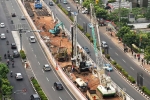Logistics ecosystem arrangement: Optimising port governance
This article has been translated by PwC Indonesia as part of our Indonesia Infrastructure News Service. PwC Indonesia has not checked the accuracy of, and accepts no responsibility for the content.
Bisnis Indonesia - Penataan ekosistem logistik: Optimalisasi tata kelola pelabuhan
24 September 2024
Bisnis, Batam – The revitalisation of Batu Ampar Port in Batam, Riau Islands, plays a crucial role in improving port organisation efficiency, which ultimately increases the competitiveness of national logistics, especially in the Malacca Strait area, which has always been the busiest route for global container traffic.
Therefore, the Cabinet Secretariat is currently focusing on the development of Batu Ampar Port. At a recent meeting with Batam Free Trade and Free Port Zone Authority (BP Batam), the Cabinet Secretariat emphasised the importance of improving port organisation efficiency. Therefore, they are asking BP Batam to optimise port management to support a favourable investment climate.
Secretariat Cabinet Economic Affairs Deputy, Satya Bhakti Parikeset, stated that the port organisation in Batam were part of the implementation of Presidential Instruction No. 5/2020 on National Logistics Ecosystem Organisation.
According to Satya, many stakeholders are involved at Batu Ampar Port, including BP Batam, Batam Port Authority and Harbourmaster Office (KSOP), Batam Customs and Excise, stevedoring businesses, shipping agents, and others.
“Cooperation among all of them is crucial to create effectiveness and efficiency in organizing ports within the Batam Free Trade Zone (KPBPB) area,” he said in his official statement on Monday (23/9).
His agency aims to ensure that the operating system at Batu Ampar Port is implemented smoothly.
“We want to ensure that the organisation of the operating system at the ports in Batam is excellently implemented by all stakeholders, supporting effective and efficient port organisation,” he stated.
Satya also mentioned that he has conducted a direct observation in the field to assess the port organisation process and the logistics ecosystem in Batam.
Meanwhile, BP Batam Deputy Head, Purwiyanto, stated that his agency aims to transform Batu Ampar Port into an international container port by enhancing its operational efficiency and services.
“BP Batam encourages investment by leveraging their authority to manage and develop Batam City, including its port sector. The effective organisation of port operations in the Batam KPBPB area is expected to boost investment in Batam,” he explained.
Meanwhile, BP Batam is currently constructing a 12-hectare container yard at Batu Ampar Port, which is set to operate in May 2025. The construction budget amounts to Rp360 billion. Additionally, BP Batam is importing STS cranes to reduce dwelling time.
Acceleration
Previously, House of Representatives (DPR) Commission VI encouraged the acceleration of Batu Ampar Port's development to reduce reliance on Singapore for export and import activities.
Until now, export products from Batam have needed to go through Singapore, as the ports in Batam cannot accommodate large-tonnage ships.
DPR Commission VI Deputy Chairperson, Martin Manurung, stated that the revitalisation is crucial to increase the export volume from Batam.
Despite initial hindrances, the revitalisation of Batu Ampar Port has progressed through the first and second stages.
He mentioned that two partners of Commission VI, namely Persero Batam under PT Perusahaan Pengelolaan Aset (PPA), a state-owned enterprise (SOE), and BP Batam, are cooperating.
“This cooperation was initially hindered, but now stages 1 and 2 have been completed. So, we will continue to support it as it progresses to stage three, in accordance with the existing plan,” he explained at the end of June.
He explained that, although the trade volume in Batam is still far behind, it has reached a new milestone with the establishment of direct calls from Batam.
Bisnis noted that Batu Ampar Port established direct calls to China at the end of March 2024 and to Myanmar in August 2024.
“At least there are now direct calls from overseas to Batam. We will continue to oversee the development of Batu Ampar Port in line with the agreed business plan at Commission VI,” he stated.
He added that the revitalisation is expected to enhance Batam's attractiveness as an international logistics and trade centre.
Batu Ampar Port is expected to accommodate more ships and handle a higher volume of cargo, thereby reducing reliance on ports in neighbouring countries.
DPR Commission VI Member, Deddy Sitorus, stated that this revitalisation is crucial for capitalising on the opportunities in the Malacca Strait area.
Moreover, he added that Malacca Strait handles around 80 million TEUs of cargo every year. By comparison, Singapore handles 45 million TEUs, while Malaysia handles around 10 million TEUs with the potential to increase to 23 million TEUs.
“Meanwhile, Pelindo currently handles only 8 million TEUs. The port can accommodate nearly 600 thousand TEUs,” he stated.
Deddy explained that the revitalisation would make export-import processes easier and more affordable, thereby increasing foreign exchange and tax revenue for the state.
He also suggested that export ships transit in Batam rather than Singapore, making cargo distribution across Indonesia more efficient.


















